Sea Cadets (United Kingdom)
| Sea Cadets | |
|---|---|
 | |
| Founded | 1856[1] |
| Country | United Kingdom |
| Type | National youth charity |
| Size |
13,710 cadets[2] 5,230 Cadet Force Adult Volunteers[2] 6 regional watersports centres 5 offshore vessels 4 national training centres |
| Headquarters | London |
| Patron | Queen Elizabeth II |
| Motto(s) | Ready Aye Ready |
| Website | www.sea-cadets.org |
| Commanders | |
| Captain Sea Cadets | Phil Russell MA MSc CEng CMarEng FIMarEST MRINA Royal Navy[3] |
| Insignia | |
| Ensign |
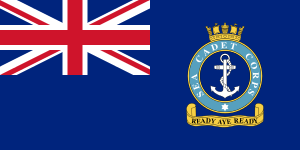 |
Sea Cadets is a national youth charity, working with 14,000 young people between 10 and 18 years old across the UK. It has 400 units across England, Scotland, Wales and Northern Ireland,[4] and Bermuda all run by 9,000 volunteers. Cadets follow similar rates and ranks, traditions, values and ethos as the Royal Navy.
Her Majesty Queen Elizabeth II is the patron of Sea Cadets and HRH The Duke of York is the Admiral of the Sea Cadets.
Cadets
Sea Cadets is an inclusive charity open to young people ages 10 to 18.
Young people have the option to join as a:
Junior Sea Cadets
For 10 to 12 year olds, Junior Cadets have their own training programme and uniform, based around a more practical version of the Sea Cadets training programme, only designed for a younger audience. When Junior Sea Cadets turn 11 years and 10 months, they can move up to being a New Entry to learn the New Entry courses, before moving up to become a Sea Cadet.
Sea Cadets
For 12 to 18 year olds, young people can join as a Sea Cadet and work their way up through the training programme.
Royal Marines Cadets
For 13 to 18 year olds, the Royal Marines Cadets are part of the Sea Cadets family.
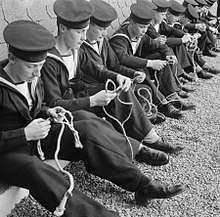
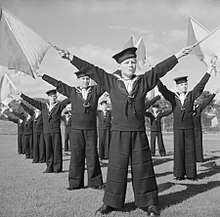
Admiral of the Sea Cadet Corps
| Appointee | From | to |
|---|---|---|
| King George VI | 1942 | 1952 |
| Prince Philip, Duke of Edinburgh | 1952 | 1992 |
| Prince Andrew, Duke of York | 1992 | Present |
Structure and organisation
National level

The Headquarters of Sea Cadets are in South London at 202 Lambeth Road, SE1 7JW. It is made up of a variety of different departments, including:
- Fundraising
- Safeguarding
- Finance
- Training
- Communications
- Events
Area level

The country is divided into six areas, which are:
- Eastern (including Malta)
- Northern (including Northern Ireland and Bermuda)
- Southern (including the Channel Islands & Falkland Islands)
- North West (including the Isle of Man)
- London
- South West
Each area is run by an Area Officer (AO) with a small team of support staff.
District level
Each area is subdivided into districts of between five and twelve units which are led by volunteers.
Unit level
Each unit is led by a Commanding Officer (CO) or Officer-in-Charge (OiC). Some units also have a Royal Marines Cadets Detachment, headed by a detachment commander (DC).
There are a variety of roles within a unit and any individual could bring different skill sets that can help a unit. A volunteer could be anything from a watersports instructor, to a fundraiser on the unit management team. Or they could simply teach football once a month. Roles are flexible and volunteers can choose whether they wish to wear a uniform or not.[5]
Training
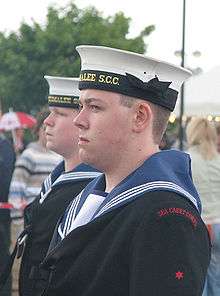
Cadet Training Programme
Cadets follow the Cadet Training Programme (CTP) where they can learn about a variety of subjects ranging from First Aid to Adventure Training and Leadership. Royal Marine Cadets also complete the CTP but have additional elements such as campcraft amongst others.
Specialisation and proficiency training
Skills learned in a cadet's time in the SCC usually fall into one of two categories - Specialisations and Proficiencies. Specialisations are often larger subjects than proficiencies, and so are split into three levels; Basic, Intermediate and Advanced, each level increasing in difficulty building on the knowledge gained from the prior levels. Basic specialisations are often gained at the unit during regular training, while Intermediate and Advanced awards are held on an Area or National basis. Proficiencies do not usually have a levelling system, though some subjects such as Piping do contain a Basic/Intermediate level.
Some specialisations, such as Marine Engineering, are also divided into disciplines such as Electrical and Mechanical engineering.
All of the following are on offer to cadets, either at the unit or on district/area/national courses.
| Specialisations | Proficiencies | Boatwork |
|---|---|---|
| Marine Engineering (Electrical/Mechanical) | Piping (Boatswains Call) | Dinghy Sailing |
| CIS (Radio Communications, Information Systems) | Meteorology | Rowing |
| Physical Training | Band/Musician | Kayaking |
| Catering/Stewarding | Adventurous Training | Power Boating |
| Navigation | Target Shooting | Windsurfing |
| First Aid | Diving | Offshore Sailing/Power Boating |
| Seamanship | Flying |
Canoeing |
| Drill/Ceremonial |
Cadets can also work towards recognised qualifications including, Duke of Edinburgh's Award and BTEC National Diplomas. These are available in Public Service, BTEC First Diploma in Music and BTEC First Diploma in Engineering (SCC Only).
Many qualifications are run by the Sea Cadets but regulated by external bodies. In these cases, cadets earn independent qualifications that they can take with them outside the Corps. These include Paddlesport, where they can gain PaddlePower or Star Awards through British Canoeing (formerly known as BCU), First Aid, where they can earn St John Ambulance First Aid certifications, Rowing, where they can earn British Rowing (BR) qualifications and Powerboating/Sailing/Windsurfing/Navigation where they can gain Royal Yachting Association (RYA) qualifications. National courses are also held, often on Royal Navy bases and at minimal cost, to teach skills such as leadership and teamwork. Specialist qualification courses include power boating in Scotland, cooking in Preston and fire fighting in Cornwall. There are competitions at varying levels in many of the sports, proficiencies and specializations of the SCC. Competitions start at a District level and progress through to National level.
Ranks and rates
Cadets
From New Entry through to Able Cadet, Sea Cadets are promoted based on their completion of various task-based modules under the CTP - Cadet Training Programme. Leading Cadets and Petty Officer Cadets are required to attend and pass a promotion board (held at area or national level) before being promoted. Emboldened are senior rates.
All Royal Marines Cadets are required to complete boards for each promotion. The higher the board the higher the level the board is run at so MC and MC2 boards are run at detachment level, MC1 boards at troop or company, Corporal boards at company and Sergeant board at a national level. All promotions boards have multiple sections all of which must be passed individually.
| Sea Cadets | (Abbr) | Royal Marine Cadets | (Abbr) |
|---|---|---|---|
| New Entry | NE | Recruit | RCT |
| Cadet | Cdt | Marine Cadet | MC |
| Cadet 1st Class | Cdt1 | Marine Cadet 2nd class | MC2 |
| Ordinary Cadet | OC | Marine Cadet 1st Class | MC1 |
| Able Cadet | AC | Lance Corporal* | L/Cpl |
| Leading Cadet | LC | Cadet Corporal | Cdt Cpl |
| Petty Officer Cadet | POC | Cadet Sergeant | Cdt Sgt |
At the discretion of the commanding officer of a unit, or district officer, a cadet may be awarded an acting rate should they have completed the majority of the modules required for promotion, or received a partial pass on their promotion board, for example. An example of such rates are Acting Leading Cadet (ALC), or Acting Petty Officer cadet (APOC).

- * High-achieving Marine Cadet 1st Class can be promoted to the rank of Cadet Lance Corporal by their detachment commander. This is an honorary rank and is not needed for progression up to Cadet Corporal. However, unlike Marine Cadet 1st class, Cadet Lance Corporal is considered a junior non-commissioned officer rank, and as such is given more leadership responsibility (equivalent of midway between Able Cadet and Leading Cadet).
| Junior Sea Cadets | (Abbr) |
|---|---|
| Junior Cadet | JC |
| Junior Cadet First Class | JCFC |
| Leading Junior Cadet | LJC |
Adult officers
At unit level the following Ranks can be awarded to the uniformed adult volunteers, There is also Non uniformed civilian instructors and Associated instructors.
| Sea Cadet Unit Officers (NCO's) | Royal Marine Unit Officers (NCO's) |
|---|---|
| Acting and Probationary Petty Officer | Acting and Probationary Sergeant |
| Petty Officer | Sergeant |
| Chief Petty Officer | Colour Sergeant |
| Warrant Officer 2nd Class | Warrant Officer 2nd Class |
| Warrant Officer 1st Class | Warrant Officer 1st Class |
| Sea Cadet Officers | Royal Marine Cadet Officers |
|---|---|
| Midshipman (SCC) RNR | Second Lieutenant (SCC) RMR |
| Sub-lieutenant (SCC) RNR | Lieutenant (SCC) RMR |
| Lieutenant (SCC) RNR | Captain (SCC) RMR |
| Lieutenant commander (SCC) RNR | Major (SCC) RMR |
| Commander (SCC) RNR - as of August 2009 | Lieutenant Colonel (SCC) RMR - as of August 2009 |
Ships
The Sea Cadets have three classes of offshore vessels, all of which are capable of coastal/offshore passage making. Sea Cadet voyages normally last for 1 week, with cadets gaining RYA qualifications for their voyage. Individual Sea Cadet units also have various boats including MOD motor boats such as Vikings, Champs, Dories, dinghies called the ASC (Admiralty Sailing Craft) and Bosuns, in addition to vessels designed specifically for the SCC such as the Trinity 500 rowing boat and RS Quest dinghy. Also on loan from the MOD, canoes, kayaks and windsurfing equipment, units and national training centres also have RIB's.
TS Royalist
- TS Royalist: the Sea Cadet flagship is a tall ship owned by the MSSC. She is used to provide week-long training courses for Sea Cadets and Royal Marines Cadets. The ship was launched in 2014 to replace TS Royalist, which was over 40 years old when decommissioned. In 2013 there had been an appeal to replace the ageing flagship: £250,000 was needed this target was achieved in April 2013.[6]
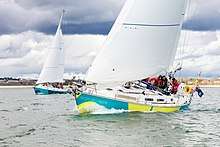
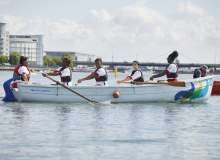
536 square metres (641 sq yd). Her draught is 3.25 metres (10 ft 8 in)
.[8] The ship's hull is of high tensile steel, with her superstructure of glass reinforced plastic. She has a crew of eight, plus up to 24 Cadets and 2 adult trainees. Twelve passengers can also be carried.[9]

TS City of London and TS Sir Stelios
- TS City of London and TS Sir Stelios are the Sea Cadets' new (2017 and 2018 respectively) Rustler 42 yachts which have replaced the Tradewinds 35s TS Vigilant and TS City Liveryman. They are both Rustler 42 yachts and provide nationally-recognised RYA training for those wishing to gain qualifications and experience yacht sailing.
TS John Jerwood and TS Jack Petchey
- These 2 vessels are the cadets' offshore powered training-ship. They are 24m long and each cost about £2.6m. TS Jack Petchey is so named because the Jack Petchey Foundation donated £1m in order for it to be built. The Jerwood Foundation donated £1,216,700 for the construction of TS John Jerwood. The training ships can hold between 12-16 cadets, 4 permanent staff and 2 CFAVs and provides an experience at sea focussing on deck work, navigation, bridge watchkeeping, cook/steward and marine engineering. Each vessel is fitted with twin Perkins Sabre Type M215C Turbo Diesel main engines, each giving 200 Shaft Horse Power at 2,500 rpm.[10]
Trinity 500 rowing boats
- The Trinity 500 is a stable fixed seat rowing boat, purpose built for the Sea Cadets to deliver the full SCC Rowing Scheme. The boat has also been approved by British Rowing, to allow for the delivery of their Explore Rowing Scheme. The boat was designed by Jo Richards, Olympic medallist and designer of a wide range of craft, in response to the requirement of the Sea Cadets for a modern, low maintenance, purpose-designed fixed seat rowing boat with good performance under oars and with the capacity to mount a small outboard motor. The Trinity 500 is named to mark the quincentenary of the incorporation of Trinity House, the statutory authority for aids to navigation in England, Wales, The Channel Islands and Gibraltar. The Trinity House Maritime Charity, a separately funded arm of the Corporation of Trinity House generously funded the design and development costs of the boat.
RS dinghies
- In a partnership between RS Sailing and the Sea Cadets, a new dinghy known as the RS Quest was designed by Jo Richards, who is also responsible for formulating the design for the Trinity 500 rowing vessel. The RS Quest was designed to accommodate the need for a new sailing dinghy within the SCC that is strong and easy to maintain which is capable of comfortably accommodating an instructor and up to three cadets. The RS Quest was unveiled at the Southampton Boat Show in 2015.
- Continuing the partnership between MSSC and RS Sailing, the single sail RS Zest dinghy was launched at the 2017 Southampton Boat Show. It is intended for a crew of two, but can be sailed single-handed. It is aimed at benefiting Units with limited access to water, as RS Zest can operate in shallower water than the RS Quest.
Investigation into sexual abuse
In 2012 payouts made to victims of sexual abuse across all Cadet Forces totaled £1,475,844. In 2013 payouts totaled £64,782, and in 2014 payouts totaled £544,213.[11]
In 2017, a BBC Panorama episode entitled "Cadet Abuse Cover-Up" highlighted sexual abuse cases in the British Cadet Forces. In a 1979 case of sexual abuse of a 14 year old cadet in Hertfordshire, the boy's parents were dissuaded from reporting the offender to police by Sea Cadet officers in full uniform, who had visited their home. The offender was neither dismissed or suspended but instead promoted to oversee 10 cadet units in London.[12] In the years 2012 to 2017 there were 28 allegations of sexual abuse made against SCC volunteers, including historical allegations. All 28 offenders were dismissed and referred to police.[12]
See also
Other elements of the Community Cadet Forces
Other MoD sponsored or recognized cadet forces
Other Sea Cadet organisations
- Australian Navy Cadets
- Bermuda Sea Cadet Corps
- Royal Canadian Sea Cadets
- Hong Kong Sea Cadet Corps
- New Zealand Sea Cadet Corps
Related articles
References
- ↑ "Sea Cadet History". www.sea-cadets.org. Sea Cadet Corps. Retrieved 7 January 2017.
- 1 2 "UK reserve forces and cadets strengths: 2015". GOV.UK. Ministry of Defence. Retrieved 18 June 2015.
- ↑ Sea Cadets Welcome New Captain
- ↑ Raisborough, Jayne (1 January 1999). "Research note: the concept of serious leisure and women's experiences of the Sea Cadet Corps". Leisure Studies. 18 (1): 67–71. doi:10.1080/026143699375069.
- ↑ https://www.sea-cadets.org/volunteer
- ↑ "New Ship Appeal". Sea Cadets. Archived from the original on 17 February 2014. Retrieved 23 February 2014.
- ↑ Durham, Nick (9 August 2013). "New Royalist to be built". Yachting Monthly. Retrieved 6 January 2015.
- ↑ "New Ship Appeal". Sea Cadets. Archived from the original on 21 February 2013. Retrieved 6 January 2015.
- ↑ "Sea Cadets award Spanish shipyard £4.8 million contract". BBC News Online. 26 July 2013. Retrieved 6 January 2015.
- ↑ "New training ship for sea cadets". Maritime Journal. 30 July 2009. Retrieved 23 February 2014.
- ↑ Quinn, Ben (28 December 2014). "Ministry of Defence pays out £2m to settle cadets' sexual abuse claims". Guardian. Retrieved 22 January 2018.
- 1 2 Razzall, Katie; MacSorley, Jane (2017-07-04). "Sex abuse was covered up at cadet forces, Panorama finds". BBC News. Retrieved 2017-07-04.